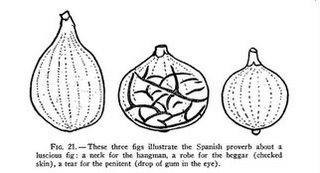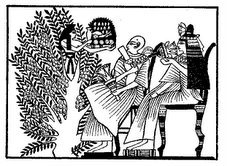(Title line from a Chinese Proverb)
Rib is (mostly) better. Wrists are less painful. Tires are pumped. Water bottle in the fridge.
update:
7/25/06
Beautiful morning for a bike ride. 55 minutes to work. Stayed away from traffic. Excellent start back to riding.
Monday, July 24, 2006
Sunday, July 23, 2006
Too Impatient

This is what I was supposed to wait for - a neck for the hangman, a robe for the beggar, and a tear for the penitent (Condit). (Does it need to be this morose?)


Here is the first Petite Negri of the year. I didn't give it enough time to ripen - it was droopy ( so did have the neck for the hangman) and starting to soften, but few scratches in the skin - "robe of the beggar".
As soon as I cut it into halves, I knew - not dark red like last year. Pink. It was sour, not sweet. Like an unripe strawberry.
Will wait longer for the next figs.
Ancient Egyptian Grape Arbor
 As long as we are on the topic of growing fruit in ancient Egypt, we can add some interesting information about grapes. According to this website, Grapes were grown as a stone age crop in Europe, and the ancient Egyptians grew grapes for wine. Certainly, grapes are a biblical crop.
As long as we are on the topic of growing fruit in ancient Egypt, we can add some interesting information about grapes. According to this website, Grapes were grown as a stone age crop in Europe, and the ancient Egyptians grew grapes for wine. Certainly, grapes are a biblical crop.If I was prepared to limit myself to a "theme", it would be fun to grow "ancient" crops - but would that leave the tomatoes? No can do.

Saturday, July 22, 2006
Fig Illustration from Ancient Egypt, in Condit's Fig Monograph

 "Illustrations of tree and fruit of the fig are found on monuments and tombs of ancient Egypt. [This illustration]... represents a fig harvest and, as LUDWIG REINHARDT(1910) states, lobed fig leaves are clearly recognizable. Three monkeys(Cynocephalus ursinus) are feasting on the figs and two men are harvesting the crop. EISEN (1930) regarded the figs... as belonging to Ficus pseudo-carica of Abyssinia, a species bearing fruit much inferior to that of F. carica" Quoted from the above reference.
"Illustrations of tree and fruit of the fig are found on monuments and tombs of ancient Egypt. [This illustration]... represents a fig harvest and, as LUDWIG REINHARDT(1910) states, lobed fig leaves are clearly recognizable. Three monkeys(Cynocephalus ursinus) are feasting on the figs and two men are harvesting the crop. EISEN (1930) regarded the figs... as belonging to Ficus pseudo-carica of Abyssinia, a species bearing fruit much inferior to that of F. carica" Quoted from the above reference.The entire monograph contains a wealth of information about the history, horticulture, and biology of figs. This is the single most respected work of "fig science". I became aware of this link from postings in the Gardenweb Fig Forum, and it is on the Cornell agricultural school web site.
Re-printing from the figure legend (since it is difficult to read here): "Picking figs in Ancient Egypt (Scene on west wall of grave No. 2, Beni Hassan, 12th Dynasty, 2500-2400 BC..... The vignette... shows an Egyptian peasant offering to the sycamore [fig]... The sacred sycamore here stands at the end of a field of corn, and would seem to extend its protection to the harvest... "
Some additional information on the sacred sycamore fig of ancient Eqypt is available here.
Figs in Ancient Egypt
 Another Illustration of a fig tree from ancient Egypt, from Condit's Monograph
Another Illustration of a fig tree from ancient Egypt, from Condit's Monograph 
This "Vignette has been reproduced from the same source, it shows an Egyptian man and wife seated in front of the sacred sycamore [fig] and receiving the bread and water of the next world." (quoted from the monograph)
Subscribe to:
Comments (Atom)